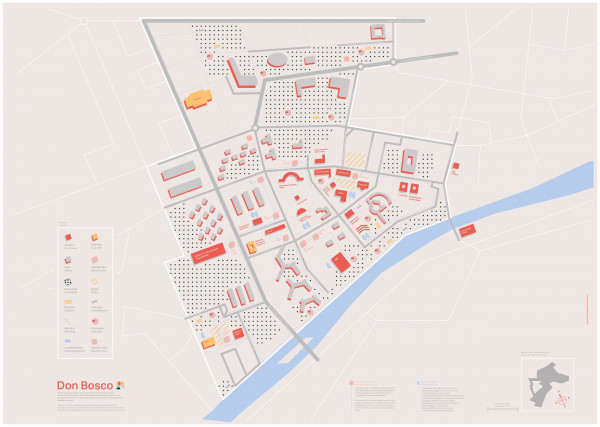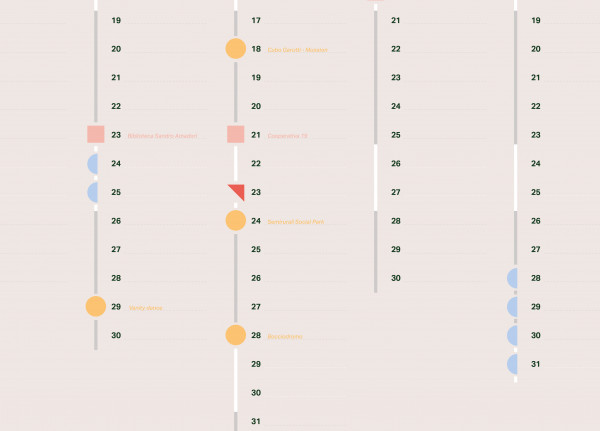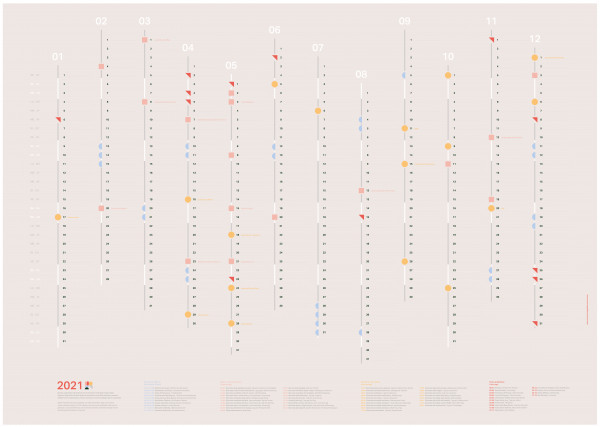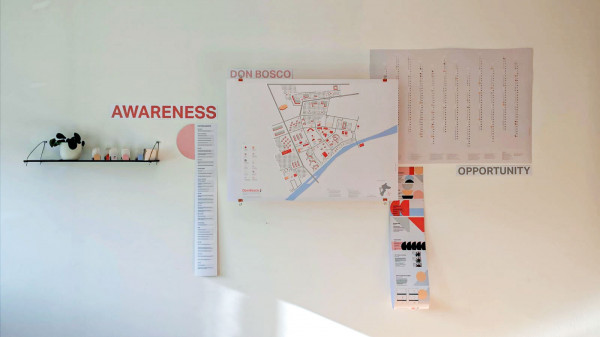MA Eco-Social Design: Project 1 by Chiara Sterzl, Michelangelo Lamonaca | WS 2020
Connesso–Verbunden
Connesso is an eco-social design project that focuses on empowering the network between all Don Bosco actors. By making the various skills and abilities of everyone visible, we want to interconnect and facilitate the collaboration among them.
text
Aim_Vision
The project aimed to identify together with the actors, all the various possibilities of exchange, increase the awareness of collaboration opportunities, and encourage them to start the first conversation.
We envision for Don Bosco a strong network where a feeling of belonging, exchange of thoughts, ideas, and skills take place
Strategy
A compilation of data resulting from intensive field research, personal interviews, and own observations, laid the basis for subsequently developed infographics.
By sharing this information, new impulses for thoughts, conversations, and approaches to work should be generated.
Outcome
A collection of office tools is the final outcome, which can be used by the workers in their daily routine.
A great map highlights all the important places in the area. Besides a general stakeholder overview, the map also shows possibilities to meet, work, or simply relax in the park. As a social activity, the included aperitivo-actor-tour invites to meet in the streets, get in touch with each other, and share the moment of the aperitif. An additional wall calendar is meant to remember all special days. Each actor is highlighted on a certain date to showcase their relevance, valuable work, and dedication to the community. To simplify contacting, all the contact persons and their addresses are listed in a developed tool called: "Actor-mazzetta". Also, personalised tea bags have been created, which expand the fantasy and stimulate action through small messages and questions on the label.

video
text
Background and matter of concern
Connesso is a project of “Transforming the City by Care” (TCC), a collaboration with the locals towards the urban regeneration of Don Bosco. We have been intrigued by the diverse network of actors populating the neighbourhood and giving several activities. In contrast to the good networking with the citizens of Don Bosco, the absence of a connection among them makes the collaboration difficult and unachievable.

Challenges
All of sudden, the worsening of the healthcare crisis has forced us at home, and consequently, we have had to rethink the steps and methods of our project. We have realized that drafting a participatory design event would have not been feasible in the way we imagined. Therefore this has implied the shift to another approaching strategy. We have planned a first familiarization with the actors through interviews held online. The unexpected circumstances made the online environment arduous to reach all the actors and create the willingness to participate in our project. Furthermore, the final realization of the approach has been developed through little steps (emails, surveys, video and phone calls) according to the individual availability of each actor.

Research activities and methods
We have started our design research from the mapping of the actors based in Don Bosco. It has been developed according to the typology of organization, communication tools, target group, fields of work, and offered activities. The clustering of the actors has brought us to the insight, that the neighbourhood boasts a rich amount of organizations working for citizenship. Although, it has resulted in the presence of several overlapping activities. The direct correspondence with Gianluca Tenin from Officine Vispa has confirmed our insights and the results on the data visualization. Furthermore, we discovered that currently only a few actors are collaborating, or had collaborated in the past. Consequently, we have planned interviews with other actors to collect further information and the expectations of collaboration with others in Don Bosco. Additionally, we used field ethnography as a design method to develop our visual identity. For this reason, we collected different colors and shapes, used in the architectures of Don Bosco to form our geometrical imagery.
image
Exploration and interventions
The development of the project has been built up through a design thinking process made of concise, structured, and planned steps. Each has been held in the online environment and it consists of different interventions whose purpose is to understand the actors' responses, think of new solutions, and adjust our intervention towards the final action.
Through a website, an email, and a gif animation, we set up an introduction of ourselves and the project idea. By creating a website, we intended to raise the awareness of the neighbourhood resources and share our findings regarding the typology of activities, the fields of focus, etc. To reach our interested actors, we sent them an email, including the link to the website, as well as the aim, vision, and benefits of connesso. A GIF animation has completed this first exploring action to provide the organizations a quick view of our logo and the members of the project team. On the website, as in the email, we asked them additionally for participation through a simple request. The tools of this project phase have implied the set up of a temporary website page (pageflow, a common template for website pages), a proper email account to give the project itself an identity (Gmail), and the creation of graphic items (through graphic software).
The next requested step has been a call for taking action into our online participatory process. Through a survey and online interviews, we gathered interesting insights into their thoughts, workflows, and wishes. The intention has been driven by the will to frame the concrete needs in the neighbourhood (multiple-choice, single-choice, and open answers to know their thoughts and opinions) as well as assuring the reliability of our data. The tools of this project phase implied the use of an interactive survey platform (ahaslides.com).
During the Christmas break, we met some of the actors in form of an online interview. Hence, we spoke about the current situation of collaboration, their perspective, and modification requests. Each of the representatives took the chance to talk openly about projects of the past, the current situation, and their plans for the future. In the last weeks of the semester, we finalized our infographics and used the newly gathered information to adjust details, delete some information, and invented new elements.

Future visions and next steps
Right now, we are ready to hand out the first outcomes of the Connesso project: our teabags for the daily breaks, the “mazzetta” with all the contacts, and our two posters, including the calendar and map of Don Bosco. In the coming months, we are planning to do a social venture called “Actor Aperitivo Tour” to make the workers of the organizations' active participants of a concrete moment of sharing and socializing. The aim is to find opportunities for growth and co-operation to make the future offers in Don Bosco rich in activities, varied, and addressed to everyone. For the future, we have envisioned a self-sufficient network of institutions, cooperatives, and associations who know each other and build a sustainable exchange system of help and support.
And don’t forget, the first step to a great relationship is always a lovely smile! :)
text
Students:
Chiara Sterzl, Michelangelo Lamonaca
Teaching Team:
Karl Emilio Pircher (Object–Spaces–Services)
Kris Krois (Communication–Interaction–Services)
Secil Ugur Yavuz (Design Research)
Sabina Frei (Moderation and Participation)
Elisa Pasqual (Information Design & Visual Storytelling)
Partner:
OfficineVispa
Municipality of Bolzano–Bozen (Ufficio Famiglia, Donna, Gioventù e Promozione sociale)
Other partners